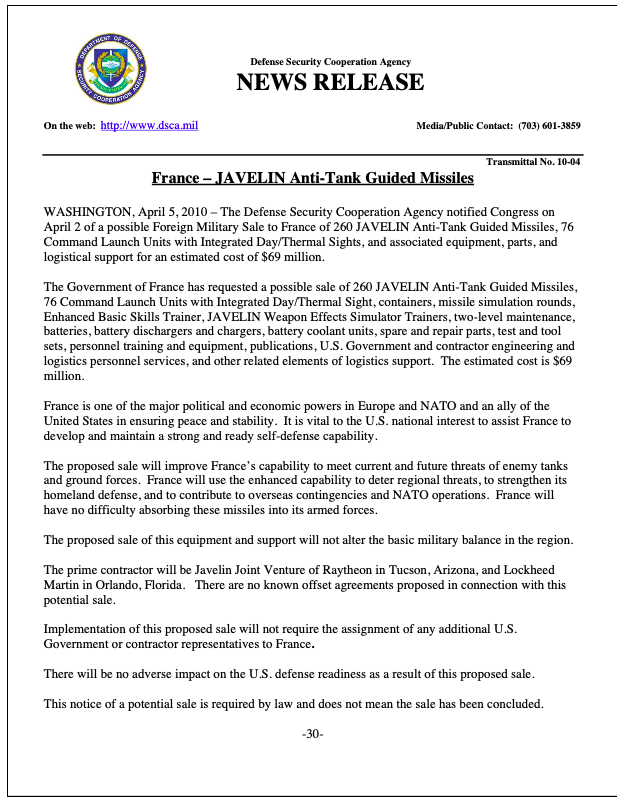Are France and NATO Shipping Depleted Uranium Weaponry Into Ukraine?
A shocking development which contravenes European and international commitments to a clean environment and protecting the health and well-being of their populations.
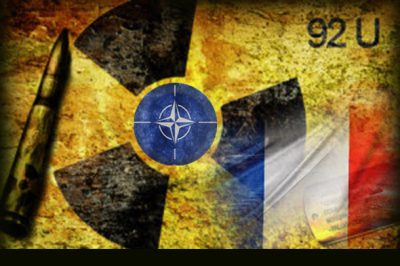
All Global Research articles can be read in 51 languages by activating the “Translate Website” drop down menu on the top banner of our home page (Desktop version).
To receive Global Research’s Daily Newsletter (selected articles), click here.
Visit and follow us on Instagram, Twitter and Facebook. Feel free to repost and share widely Global Research articles.
***
During a phone call with Ukrainian President Volodymyr Zelensky this past week, President Emmanuel Macron insisted that France would step up its military and humanitarian support for Ukraine.
There is no question that Macron is committed in this respect. Following his re-election during the final round against challenger Marine Le Pen, he was adamant about his desire to work actively during his second term to restore Ukraine’s sovereignty and territorial integrity, while always maintaining close coordination with his European partners and allies. He also indicated France’s readiness to contribute to an agreement that provides security guarantees for Ukraine.
Of course, a key part of this support is the supply of weapons. Since the beginning of the conflict in Ukraine, France has always refused to specify exactly what type of armaments it was sending to Kiev.
The secret was finally revealed by Macron himself during an interview he gave on Thursday 21stApril to news media outlet Ouest France.
When asked if Europe was in the process of supplying heavy weapons, especially tanks, as Germany has done with its Leopard tanks, he replied:
Everyone takes their responsibilities with their political balances, and I do not interfere in the political life of others. We are very coordinated. The day before yesterday I spoke to Chancellor Scholz on this subject. We still deliver substantial equipment, from the MILAN [anti-tank missiles] to the Caesars [guns], including several types of weapons. I think we have to continue on this path. Always with a red line, which is not to enter into co-belligerence.
The interviewer went on asking if tanks were necessary, and this is Macron’s reply:
Some countries have made this choice. It is a debate at the heart of German political life, it is a choice that belongs sovereignly to Germany, and we respect it. We have the same strategy as the Chancellor, which is to say: we must help the Ukrainians as much as possible, but we must be careful never to be co-belligerent.
Furthermore, Agence France-Presse (AFP) asked the Élysée Palace for comments, but they did not specify the number of MILAN missiles and Caesar guns delivered, so as not to “give operational information” which could be used by the Russian Army.
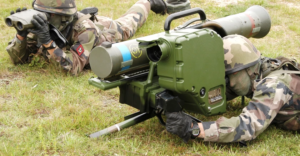
Milan anti-tank missiles.
An Elysian source specified that a few dozen MILAN anti-tank missiles (French-German manufactured) “have already been given” to the Ukrainian armed forces, confirming that these weapons were taken from the stocks of the French armed forces, according to the Elysée Palace (although these numbers seems very conservative).
The delivery of the Caesars guns was already in progress at the time, and is believed to have been shipped out with thousands of potentially lethal shells en route to Ukraine.
Spurred on by a voracious defense industry lobby, western leaders have been pouring unprecedented amounts of money and arms into this conflict zone. Since the start of Russian’s military intervention in Ukraine, some 13 billion euros worth of humanitarian, military, and financial support has been provided by G7 and European Union countries, according to data provided by the Kiel Institute for the World Economy and reported by Bloomberg.
According to L’Opinion, French aid covers several different areas. One of the most important contributions also relates to satellite imagery. France has several observation satellites (Helios, Pléiades and CSO) which allow it to provide images several times a day to the Ukrainian general staff. It is likely that this activity will place the French in close collaboration with the allies, particularly with the United States military.
Referring to French aid which is worth a total of 120 million euros (if not more), French news media L’Opinion clarified that France also offered Javelin anti-tank missiles, and Mistral short-range anti-aircraft missiles.
Light missiles:
France delivered at least three types of light missiles:
- Old MILAN anti-tank systems
- Javelins anti-tank missiles (US made)
- Mistral Short-range Anti-Aircraft Missiles
The French government is yet to release the exact volume of these deliveries.
The supply of these weapon systems was also accompanied by the training of Ukrainian military personnel called upon to implement them.
It is not a state secret that Emmanuel Macron likes to pose as the guarantor of the Paris Agreement for the climate and sometimes as the Ambassador of the One Health Approach which was resumed in his 24th May 2021 speech which he gave at the 74th World Health Assembly in the presence of Director-General of the World Health Organization, Tedros Adhanom Ghebreyesus.
This article will now focus on the actual weapons France and its allies are sending to Ukraine and examine the real danger they represent – not only for the environment, but also to people’s health.
According to the various statements made by Macron’s government, we can gather that Milan missiles, Caesar guns and shells, are the bulk of these deliveries. It is very clear that this material was chosen because it meets the following criteria:
- End-of-life equipment (old)
- Depleted uranium bombs/missiles
This second item is by far the most problematic. Before analyzing these weapons it is important to understand the knowledge and perception associated with the use of Depleted Uranium (DU) munitions in military warfare.
Which raises the obvious question: are France and NATO shipping depleted uranium weaponry into Ukraine? As this article will demonstrate, the preponderance of evidence strongly indicates that they are doing this. And the ramifications are huge, not just politically, but also legally, environmentally, as well as regarding health effects to combatants in this war. Most importantly though, we are really talking about the long-term public health for people living in and around the country of Ukraine – through the careless spreading of highly toxic and radioactive material in the region.
What is Depleted Uranium?
Watch this brief video presentation of the risks posed by DU munitions:
According to the European Commission and their Scientific Committee on Health and Environmental Risks (SCHER), depleted uranium is a dense metal produced as a by-product of enrichment of natural uranium for nuclear fuel. It is still radioactive, but at a lower level than the material at the beginning of the process. It is used in armour-piercing ammunition, shells and bombs, in order to provide more penetrating power. Such munitions were used in many wars including in both Gulf Wars in Iraq, and also in NATO’s war against Yugoslavia, specifically in battle theatres like Serbia and Kosovo.
Their repeated use has raised concerns about health threats from exposure to the distributed uranium material and particle dust. Many studies have reported evidence of its prevalence, as well as a lack thereof, depending on whose report you are reading. Suffice to say, reporting on this subject still remains very controversial.
The European commission is well aware of the hazards such weapons represent, here for instance one of the many replies from the European Commission, addressed to Florent Pirot, the Secretary of the European Association Against Depleted Uranium (EAADU):

For this reason, France’s weapons deliveries into the Ukraine war zone will have international implications. The International Coalition to Ban Uranium Weapons (ICBUW) appears to be advocating for a ban on the use of uranium in all conventional weapons and weapon systems, and is engaged in monitoring, health care, compensation, and environmental remediation for communities affected by its use. However, this group has a very limited definition of DU weapons and munitions.
Sadly the ICBUW seems to believe that only a limited number of depleted uranium weapons, namely 105 and 120 mm tank shells, and small caliber bullets (15/25/30 mm) represent an actual danger to people and the environment, which naturally triggers the usual criticism towards the US government and others like it when such munitions are used, and therefore completely ignoring aircraft-dropped bombs (GBUs), cruise missiles, and other types of anti-tank missiles.
Why would that be?
The topic of depleted uranium is a sensitive one, even though governments have more or less acknowledged the use of uranium in these weapons. Yet, the fact remains that they are used much more widely, because of uranium being the best penetrator against tanks and bunkers.
During our research, we were amazed to find so many reports and cases where higher concentrations of uranium were found near bomb craters and other sites where missiles and bombs have landed. We are meant to believe missiles or bombs land away from the populated areas, but in the reality of warfare, such assumptions are simply not accurate.
An excellent article published 19 June 2016 by Florent Pirot the EAADU Secretary, provides a trove of information and data on this subject including a link to The Washington Spectator who published a damning report entitled “Irradiated Iraq: The Nuclear Nightmare We Left Behind,” which describes the health effects, including horrendous birth defects, resulting from the US military’s prolific use of weapons made with depleted uranium.
Although Barbara Koeppel, who wrote this article faced the wrath of the usual scientific experts (which reminds me of the scientific experts of the COVID 19 so-called pandemic), it is hard to ignore the alarm sounded in 2000 of Dr. Rosalie Bertell, a cancer research scientist and consultant to the U.S. Nuclear Regulatory Commission (she died in 2012), who stated that, “DU is some thousand times more radioactive than the uranium found in soil and rock.
“Regardless of whether the bombs, bullets, or missiles are made with depleted, un-depleted, or slightly enriched uranium, they are all radioactive”.
Now let’s take a look at the weapons and ammunitions Macron is currently sending to Ukraine.
MILAN anti-tank guided missile
The MILAN is a product of Euromissile, a Franco-German missile development program dating back to the 1960s. The system entered service in 1972 as a second generation anti-tank guided missile, and soon became a standard anti-tank weapon throughout NATO, in use by most of the alliance’s individual armies.
With its rather short range (2000 meters), it is an old anti-tank guided missile (ATGM), and is known for its depleted uranium contents.
To put things into perspective, it is important to be aware that between 1986 and 2003, European armies such as the Italian Army’s combat units, were equipped with MILAN shoulder-fired anti-tank missiles, which emitted thorium-232, a notoriously radioactive metal which emits particles that are six times more hazardous to human health than those released by already hazardous depleted uranium.
Below you can see in Ukraine, the Ukrainian Defense Forces are undergoing intensive training in mastering MILAN-2 anti-tank systems.
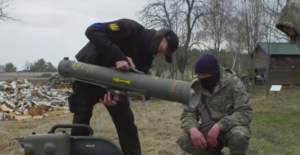
The MILAN-2 ATGM in service in Ukraine, footage from a CNN video (April 2022).
The MILAN system was designed as per the requirements of the German and French armed forces whilst still considering the general requirements of NATO Command for such weapons.
Thus, the international association Euromissile has developed a system that, due to its high performance, has become the most widely used (after the TOW ATGM) of all anti-tank missiles, currently deployed in different countries.
The MILAN anti-tank system is used by military ground forces in 40 countries, including Germany, France, other NATO countries, and of course now Ukraine.
Watch this brief presentation on the MILAN 2 anti-tank system:
The use of depleted uranium weapons is again causing concern. I am saying this with the people of Serbia and Kosovo in mind, who discovered that the conflict which ended in 1999-2000 had left serious levels of radioactive contamination, just as it did in Kuwait some nine years before.
Why do the United States and NATO allies continue to use a waste product of the nuclear industry in their weapons? Some commentators allege that it is a conspiracy between the military and the nuclear industry to dispose of dangerous waste in hostile countries. While this may be partly true, the real reasons are certainly more complex.
As we speak, depleted uranium munitions are being fired on a regular basis at one of France’s military testing grounds, known as Canjuers. Many French soldiers have reported on the danger associated with the MILAN anti-tank guided missile. The following is the kind of comment you will hear from soldiers using it:
“Depleted uranium, we use it everyday in Canjuers” – they said “Do not come near the target, it is contaminated with depleted uranium, this is dangerous” (soldier explaining what the officer told them when training with Milan missiles in Canjuers).
More of these testimonies can be found here.
The ‘Javelin’ anti-tank missile
The Javelin, although known largely as an anti-tank missile packing a high-explosive anti-tank (HEAT) round that can penetrate the latest armor, is really a multi-role shoulder-launched missile system capable of taking out everything from heavy armor, to troops hiding behind cover, to low and slow flying aircraft. Its reusable command launch unit can also be used independently as a thermal imaging surveillance system which can drastically improve austerely equipped troops’ ability to surveil their surroundings, especially at night. It features wide-angle viewing modes as well as a zoom-in mode of up to 12X.


Javelin anti-tank missile.
Ukraine has recently received American, but also French military support which includes thousands of Javelin anti-tank missiles. All the data presented by the Ukrainian military confirms that these Javelins have depleted uranium warheads. The missile and its launcher – the Command Launch Unit – together weigh 48.8 pounds, while the missile alone weighs 33 pounds, due to the extreme density and weight of DU material.
According to Florent Pirot’s article, the Javelin missiles’ depleted uranium remain a terrible threat for the environment long after the battle is over – so much so, that it will make it impossible to live in an area where these weapons were used, and not until a magnetic cleaning operation is enforced, and even then it still remains work that requires several passings in order to be left in a satisfactory state.
Pirot goes on to describe this as a crime to use these DU weapons, and unfortunately the Ukrainians’ belief they have achieved some tactical military superiority is somewhat naive, if not gullible, with respect to the low range and severe long-term risks posed by these weapons.
Given its incredibly dense nature, depleted uranium has been used for both tank armor and also in anti-tank ammunition. Depleted uranium is uranium with much of the U-235 removed. It is basically what is left over after the process of enrichment. Coupled with a shaped charge, a depleted uranium round and the DU dart contained inside it, can go through most tank armor, hence, the reason why Javelin anti-tank missiles have now become a symbol of Ukrainian resistance.
On April 5, 2010, the US Defense Security Cooperation Agency notified Congress on a possible Foreign Military Sale to France of 260 JAVELIN Anti-Tank Guided Missiles, 76 Command Launch Units with Integrated Day/Thermal Sights, and associated equipment, parts, and logistical support, for an estimated cost of $69 million.
It is fair to assume that France took possession of Javelin antitank missiles from the US, and sent some of its armed forces stock to Ukraine.
Mistral Short Range Anti-Aircraft Missiles (SATCP)
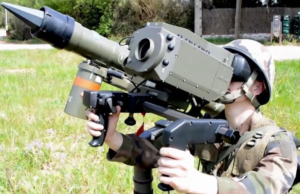
The MISTRAL is manufactured by Matra (now MBDA). Its first version was put into service in the French army in 1989. It is a very short-range surface-to-air weapon system intended to complete the surface-to-air coverage of the armored and mechanized corps. It provides isolated units with their own air defense capability. Its targets are airplanes flying up to Mach 1.2 between 10m and 3000m and helicopters in motion or hovering. Its range is over 6km.
Watch the following brief presentation on the MISTRAL mobile SAM system:
UK Next Generation Light Anti-Tank Weapon (NLAW)
We thought it would be unfair to not mention the British government, who out of the kindness of their heart have donated thousands of Next Generation Light Anti-Tank Weapon (NLAW) anti-tank guided missiles (ATGM) to Ukraine.
This missile system weighs 12.5 kg each, and has a range of no more than 1 kilometre. These features indicate that these missiles (made by Sweden’s leading defense contractor Saab Bofors, and manufactured in Ireland) include a substantial amount of depleted uranium. Given its density, even relatively small quantities of DU would add significant mass to a missile, greatly curtailing its range, but with the added benefit of its armor penetrating ability.
These missiles explode above the tank to spray it with DU together with the surroundings.
We now know that there have likely been at least 8 shipments of these missiles sent. “Thousands” of NLAWs have been promised, meaning thousands of kilograms of depleted uranium has already entered Ukraine.
Journalist Fra Hughes from Al Mayadeen explains the potential legal conundrum for countries like Sweden who are trafficking arms under the cover of a NATO-sponsored proxy war:
“One of the communications unveiled quite clearly that the Swedish government does not want the Ukraine government to publicly acknowledge its acceptance of these deadly weapons, which were dispatched on March 25, 2022, one day after the Swedish Parliament confirmed it would send aid to Ukraine.
There are many military weapons manufactured by both private arms companies and governments, which are in contravention of international law and or the Geneva convention.
Examples include depleted uranium which is used in ammunition that remains radioactive for decades. The American army used these munitions in Fallujah (Iraq), leading to severe birth abnormalities among the local population.
Air to ground missiles and bombs containing phosphorous are also banned under international law.”
Again, these weapons are a known environmental and radioactive hazard, and when used in areas where civilians live, one can easily see why some, including weapons experts, regard their prolific use as a crime against humanity.
Click here to continue reading.
*
Note to readers: Please click the share buttons above or below. Follow us on Instagram, Twitter and Facebook. Feel free to repost and share widely Global Research articles.
All images in this article are from 21CW


